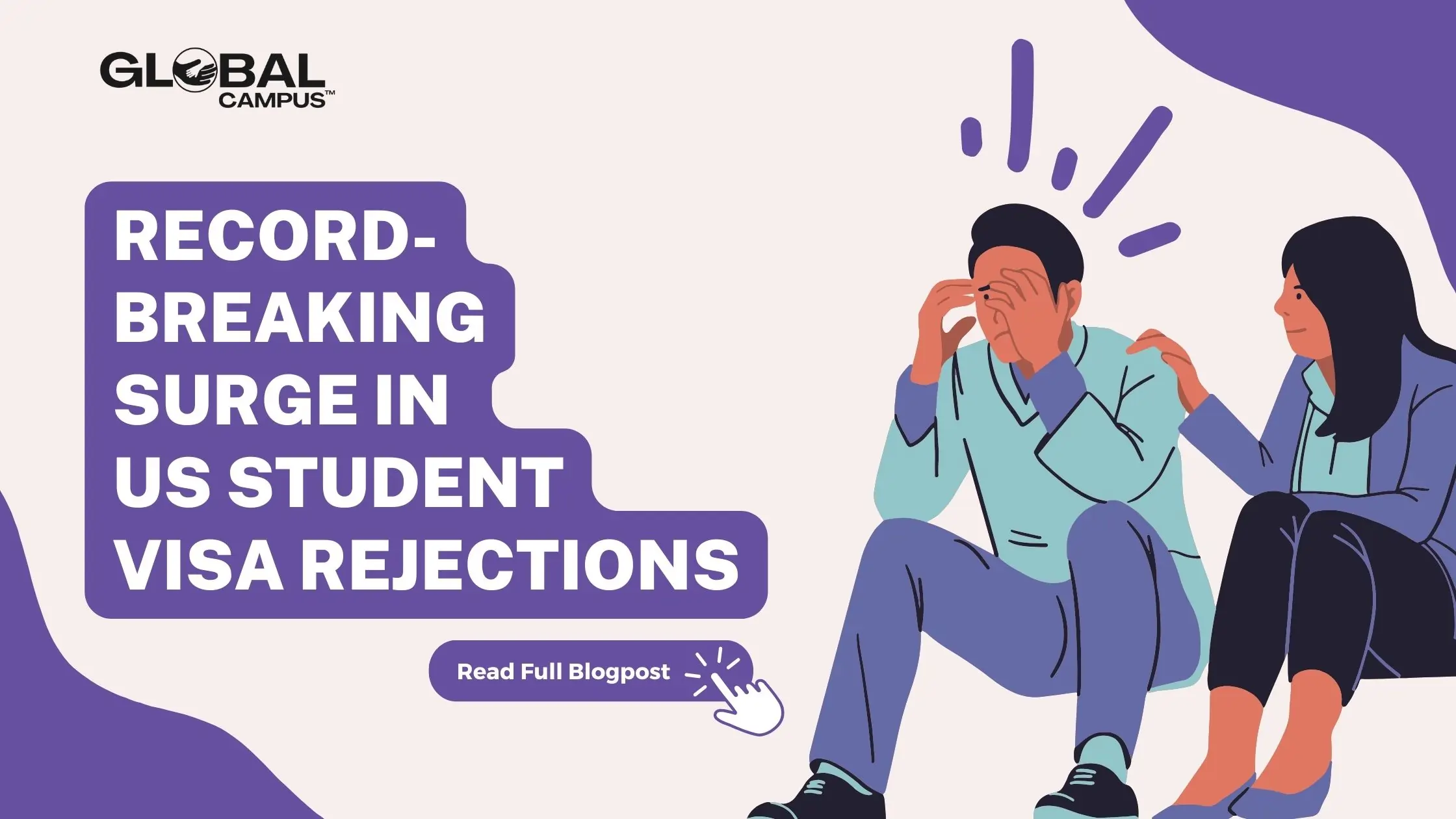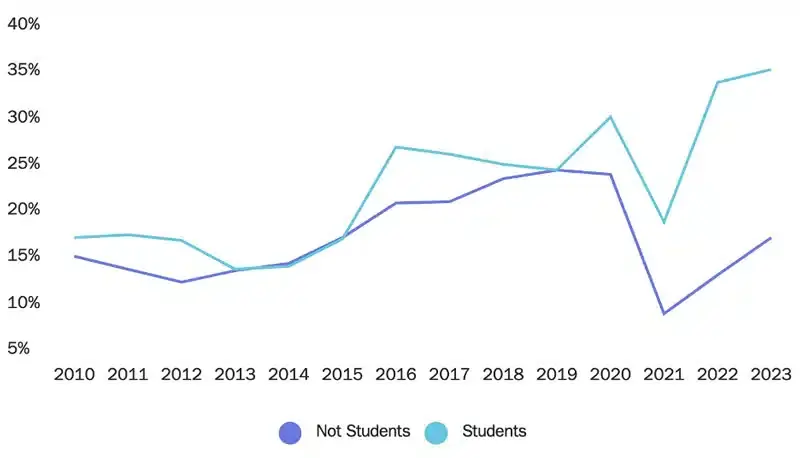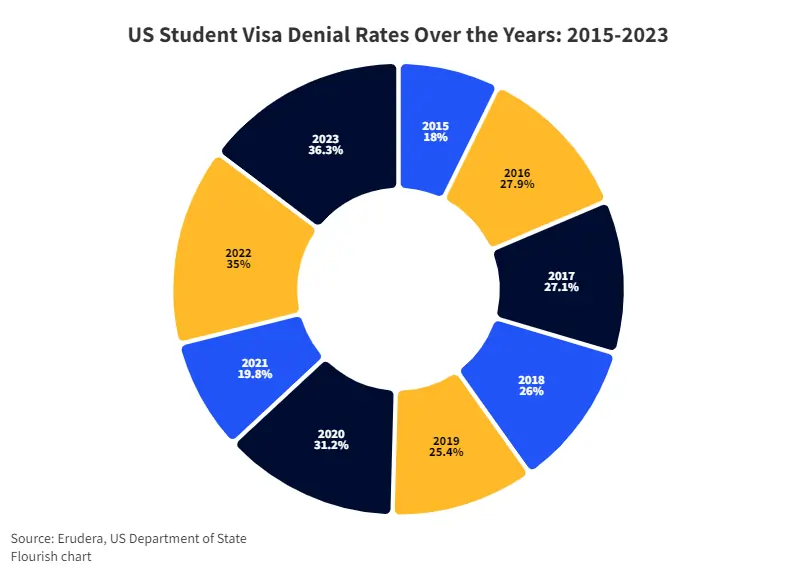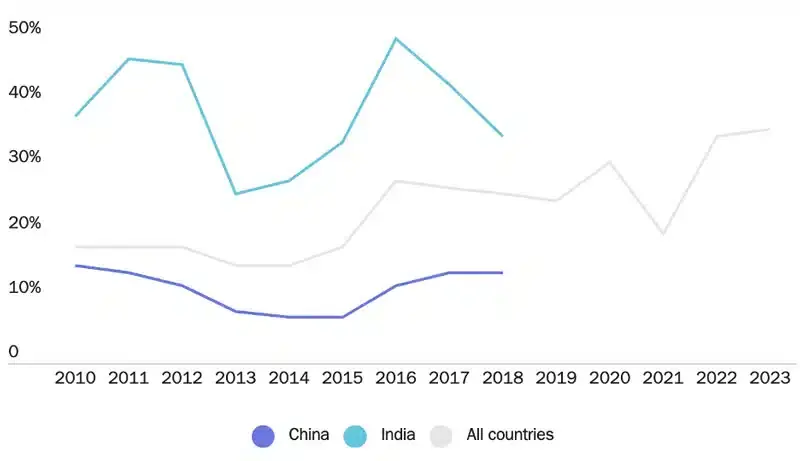
Easy Formula to Convert 10 Point CGPA to 4 Point GPA
Learn how to effortlessly convert your 10-point Indian CGPA to the 4-point GPA system used in the US with this comprehensive guide. Book a free consultation.

The United States has always been considered a leading destination for foreign education, drawing students from around the world. But according to new data, the number of US student visa applications rejected reached an all-time high in 2023—more than 250,000—and this presents a worrying picture. This represented the greatest percentage of rejection in the past twenty years, causing widespread worry among academic communities and beyond.
As we explore the complex terrain of student visa adjudication, it becomes evident that the ramifications go well beyond personal goals. It is crucial to comprehend the motives behind this significant increase in rejections, since it has severe economic consequences and potential impacts on diplomatic relations. Come along as we examine the impact, break down the data, and investigate the underlying mechanisms influencing this phenomenon.
Last year, the United States denied more than 250,000 applications for student visas, the greatest rate of denial in 20 years. With 253,355 refusals of F-1 visas in 2023, the refusal rate skyrocketed to 36%—even higher than in 2022. Furthermore, according to US government data cited in an essay by David J. Bier, associate director of immigration research at The Cato Institute, the rate of denial for student visas was almost twice that of denial for other types of visas. Indian students were the most likely to be rejected, making up about 29% of the total, according to the Cato Institute.
The overall number of college students enrolled has decreased dramatically over the past ten years. The State Department does not specifically outline the reasons for student visa denials, but almost all nonimmigrant visa denials are for failing to prove “nonimmigrant intent” (that is, the desire not to move to the United States permanently),” according to David J. Bier, associate director of immigration studies at The Cato Institute. Demonstrating non-immigrant intent requires applicants to provide evidence of strong connections to their native country that would compel them to return after their visa expires.
According to a US immigration lawyer, if there is a strong possibility that a visa applicant would exceed their authorised stay, consular authorities have significant discretion to reject the application, and they are highly unlikely to face any consequences for doing so.
“Consular officials possess knowledge of fraudulent activities occurring in other nations and exercise caution and discernment when granting approvals.” Some individuals still maintain the belief that they serve as a barrier against an overwhelming influx of migrants.
Bier has expressed concerns with the State Department’s approach to visa interviews, which he considers an “absurd method of adjudicating student visas.” These interviews, which occasionally conclude in less than two minutes, have generated questions about the department’s management of the process.
Students, who usually lack substantial economic and social connections compared to more established visa applicants and intend to stay in the US for a longer period, face the particularly challenging task of proving their non-immigrant intent.
“Genuine students who genuinely want to study here are being rejected due to this uncompromising policy measure,” as per Bier.

Refusals of student visas relative to other US non-immigrant visa categories, 2010–2023.
Source: Cato Institute and US Department of State


Student visa refusal rates for Chinese and Indian students compared to those from all other countries, 2010–2023.
Source: US Department of State, Cato Institute
The rising incidence of student visa rejections in the United States seems to be causing a decrease in the number of applicants. The fall in visa issuances between 2015 and 2023 can be attributed to a reduction in application numbers and a declining approval rate, resulting in a significant 31% decline.
Mr. Bier has analysed the impact of these patterns on the overall United States economy:
Prior to applying for an F-1 visa, it is crucial to comprehend that a student must already have received acceptance into a university that is allowed by the government. The US Department of State rejected a total of 253,355 students who were expected to contribute around $30,000 per year, or a total of $7.6 billion per year in tuition and living expenses. After a span of four years, the aforementioned figure escalates to $30.4 billion in economic gains that the United States has lost.
In November 2023, NAFSA measured the economic impact of international students in the US. According to their findings, during the 2022–2023 academic year, over one million international students in US colleges and universities contributed over US$40 billion to the US economy. This amount increased by almost US$6.3 billion (nearly 19%) compared to the previous academic year. Additionally, these students supported more than 368,000 jobs. NAFSA has been attempting for several years to widen dual intent for F-1 visa applications, allowing students to express an interest in staying in the United States after completing their degree without jeopardising their visa approval chances, but this campaign has not seen the light of day yet.
Although there are several causes contributing to the situation, Mr. Bier highlights that the increase in Indian candidates appears to be particularly influential. Indian applicants accounted for 29% of all visa issuances in 2023 and have historically faced a higher likelihood of visa refusal compared to Chinese students.
Regardless of the data-driven factors contributing to the increasing refusal rate, Mr. Bier suggests that the rise is mostly driven by the subjective discretion used by US immigration officers during student visa interviews, rather than any official immigration plan.
An illustration is given by Don Heflin, the chief of the Consular Affairs division of India, who elucidated in 2022 the approach his team adopted for conducting visa interviews:
The main focus of student visa interviews is to describe why this school and program make sense to you. In American English, this is referred to as the elevator pitch. You will have a minute and a half to explain why this [school] makes sense to you. Avoid memorizing information about the school’s campus, student body, and history of school.
Mr Bier deems this approach as “ridiculous” and expresses astonishment that the US government will happily forgo billions of dollars in revenue from prospective students only because they have memorised their concise explanation of why they wish to pursue computer science studies in Kansas. It is completely irrelevant. He goes on to say, “The administration needs to increase transparency about student visa denials and adopt a fair and uniform policy for reviews.”
Educators are also concerned about the detrimental effects on America’s people-to-people relations, as well as the damage to the country’s reputation as an attractive study location, which may cause potential students to apply elsewhere.
The narrative surrounding the increasing number of student visa rejections in the United States is one that is filled with intricacy and significance. The stakes are undeniably high, considering the economic fallout of billions in lost revenue and the erosion of America’s global standing as an educational hub. As policymakers, educators, and stakeholders wrestle with these challenges, it is evident that there is a growing urgency for a fair, consistent, and logical approach to visa adjudication.
By creating a welcoming and diverse environment, the United States can reaffirm its dedication to academic excellence, innovation, and inclusivity. As we move forward, it is important to remember the significant impact that education can have on bringing people together, promoting empathy, and creating a better future for future generations.
Suggested Reading: Studying in USA Can Destroy Your Career | H1-B Trap
The increase in student visa rejections is driven by a number of variables, including changes in immigration regulations, increased scrutiny by US immigration officers, and subjective decisions made during visa interviews.
International students confront numerous problems, including financial losses due to disallowed tuition and living fees, interruptions to academic endeavours, and uncertainty regarding their future educational and career choices.
While precise grounds for visa rejection are not usually given, factors such as perceived possibility of overstaying, lack of strong ties to the home country, and subjective decision-making during interviews all contribute to varied refusal rates among countries.
Various stakeholders, including educational institutions, advocacy groups, and lawmakers, are lobbying for improved openness, justice, and reforms to the US student visa application process in order to alleviate the negative effects of rising rejection rates.
Prospective overseas students should conduct extensive study on visa regulations, produce detailed evidence establishing strong ties to their home country, and successfully express their academic and career ambitions during visa interviews to improve their chances of approval.
US educational institutions should take proactive steps to promote a more welcoming and inclusive atmosphere for students from varied backgrounds, such as awarding scholarships, providing extensive support services for international students, and campaigning for legislation improvements.

Learn how to effortlessly convert your 10-point Indian CGPA to the 4-point GPA system used in the US with this comprehensive guide. Book a free consultation.

Unlock the secrets of studying in the USA with our comprehensive blog! Discover essential considerations before pursuing education in the USA!
Aapka Ek Ek Sawal,
Humaare do do Jawaab
Fill in your details & we’ll call you back within 48 hours.
Fill in your details & we’ll call you back within 48 hours.